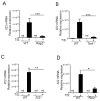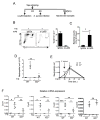IL-22 derived from γδ T cells restricts Staphylococcus aureus infection of mechanically injured skin
- PMID: 27543072
- PMCID: PMC5056816
- DOI: 10.1016/j.jaci.2016.07.001
IL-22 derived from γδ T cells restricts Staphylococcus aureus infection of mechanically injured skin
Abstract
Background: Staphylococcus aureus is an opportunistic pathogen that colonizes the skin of patients with atopic dermatitis (AD) and aggravates their disease. Neutrophils and the cytokines IL-17A and IL-17F, which drive the expression of the neutrophil-attracting chemokines, are important for the clearance of S aureus infection. The cytokine IL-22 is often coproduced by IL-17-secreting cells. The levels of IL-22 are elevated in AD skin lesions.
Objective: We sought to determine the role of IL-22 in the clearance of S aureus infection of mouse skin subjected to tape stripping, a surrogate for scratching, a cardinal feature of AD.
Methods: S aureus was applied to the tape-stripped skin of wild-type and Il22-/- mice. Bacterial burden was evaluated by enumerating colony-forming units. Quantitative PCR and ELISA were performed to quantify Il22 mRNA and IL-22 protein in mouse and human skin. Flow cytometry was used to enumerate neutrophils in the skin.
Results: Scratching the skin of healthy adults and tape stripping of mouse skin induced local expression of Il22 mRNA and IL-22 protein. Induction of Il22 expression by tape stripping was dependent on IL-23 and γδ T cells. Clearance of S aureus from tape-stripped skin was significantly impaired in Il22-/- mice. Neutrophil infiltration and upregulation of expression of genes encoding the antimicrobial peptides antigen-6/urokinase-type plasminogen activator receptor related protein-1 and β-DEFENSIN 14 and the chemokine (C-X-C motif) ligand following tape stripping were significantly impaired in Il22-/- mice.
Conclusions: These findings show that IL-22 is important for limiting the growth of S aureus on mechanically injured skin and caution that IL-23 and IL-22 blockade in patients with AD may enhance susceptibility to staphylococcal skin infection.
Keywords: AD; IL-22; S aureus; neutrophils.
Copyright © 2016 American Academy of Allergy, Asthma & Immunology. Published by Elsevier Inc. All rights reserved.
Figures






Similar articles
-
Basophil-derived IL-4 promotes cutaneous Staphylococcus aureus infection.JCI Insight. 2021 Nov 8;6(21):e149953. doi: 10.1172/jci.insight.149953. JCI Insight. 2021. PMID: 34747366 Free PMC article.
-
DOCK8 is essential for neutrophil mediated clearance of cutaneous S. aureus infection.Clin Immunol. 2023 Sep;254:109681. doi: 10.1016/j.clim.2023.109681. Epub 2023 Jun 28. Clin Immunol. 2023. PMID: 37385324 Free PMC article.
-
Effects of Josamycin on Scratching Behavior in NC/Nga Mice with Atopic Dermatitis-Like Skin Lesions.Biol Pharm Bull. 2021;44(6):798-803. doi: 10.1248/bpb.b20-00976. Biol Pharm Bull. 2021. PMID: 34078811
-
What is the role of Staphylococcus aureus and herpes virus infections in the pathogenesis of atopic dermatitis?Future Microbiol. 2017 Nov;12:1327-1334. doi: 10.2217/fmb-2017-0081. Epub 2017 Oct 20. Future Microbiol. 2017. PMID: 29052452 Review.
-
The Role of Staphylococcus aureus in Secondary Infections in Patients with Atopic Dermatitis (AD).Pol J Microbiol. 2016 Aug 26;65(3):253-259. doi: 10.5604/17331331.1215600. Pol J Microbiol. 2016. PMID: 29334062 Review.
Cited by
-
Mammary γδ T cells promote IL-17A-mediated immunity against Staphylococcus aureus-induced mastitis in a microbiota-dependent manner.iScience. 2023 Nov 14;26(12):108453. doi: 10.1016/j.isci.2023.108453. eCollection 2023 Dec 15. iScience. 2023. PMID: 38034361 Free PMC article.
-
Linker-Improved Chimeric Endolysin Selectively Kills Staphylococcus aureus In Vitro, on Reconstituted Human Epidermis, and in a Murine Model of Skin Infection.Antimicrob Agents Chemother. 2022 May 17;66(5):e0227321. doi: 10.1128/aac.02273-21. Epub 2022 Apr 13. Antimicrob Agents Chemother. 2022. PMID: 35416713 Free PMC article.
-
γδ T cell-intrinsic IL-1R promotes survival during Staphylococcus aureus bacteremia.Front Immunol. 2023 Jul 7;14:1171934. doi: 10.3389/fimmu.2023.1171934. eCollection 2023. Front Immunol. 2023. PMID: 37483624 Free PMC article.
-
Langerhans Cells: Sensing the Environment in Health and Disease.Front Immunol. 2018 Feb 1;9:93. doi: 10.3389/fimmu.2018.00093. eCollection 2018. Front Immunol. 2018. PMID: 29449841 Free PMC article. Review.
-
The primary mechanisms underlying atopic dermatitis.Tunis Med. 2025 Jan 5;103(1):65-72. doi: 10.62438/tunismed.v103i1.5220. Tunis Med. 2025. PMID: 39812196 Free PMC article. Review. English.
References
-
- Spergel JM, Paller AS. Atopic dermatitis and the atopic march. J Allergy Clin Immunol. 2003;112:S118–27. - PubMed
-
- Tauber M, Balica S, Hsu C-Y, Jean-Decoster C, Lauze C, Redoules D, et al. Staphylococcus aureus density on lesional and nonlesional skin is strongly associated with disease severity in atopic dermatitis. J Allergy Clin Immunol. 2015 - PubMed
-
- Novak N, Bieber T, Leung DYM. Immune mechanisms leading to atopic dermatitis. J Allergy Clin Immunol. 2003;112:S128–39. - PubMed
MeSH terms
Substances
Grants and funding
LinkOut - more resources
Full Text Sources
Other Literature Sources
Research Materials

